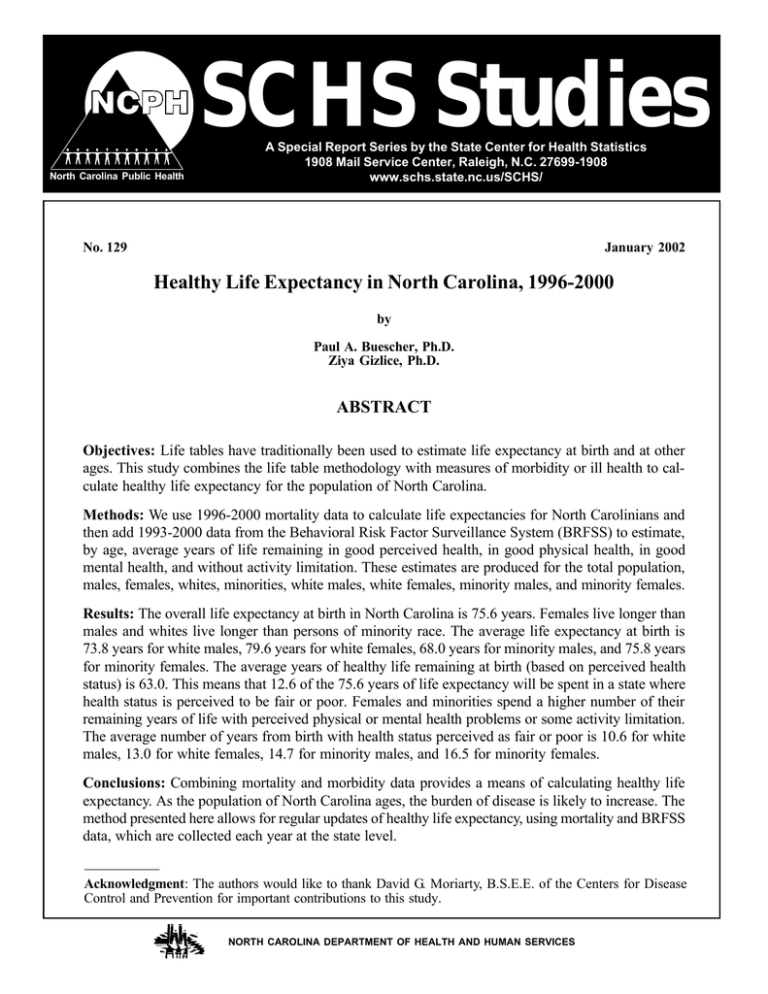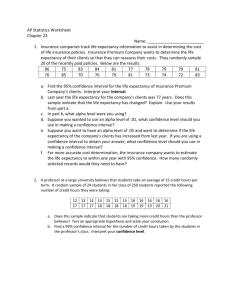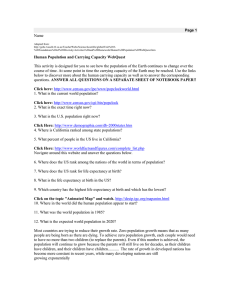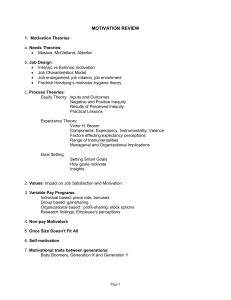SCHS Studies
advertisement

SCHS Studies North Carolina Public Health A Special Report Series by the State Center for Health Statistics 1908 Mail Service Center, Raleigh, N.C. 27699-1908 www.schs.state.nc.us/SCHS/ No. 129 January 2002 Healthy Life Expectancy in North Carolina, 1996-2000 by Paul A. Buescher, Ph.D. Ziya Gizlice, Ph.D. ABSTRACT Objectives: Life tables have traditionally been used to estimate life expectancy at birth and at other ages. This study combines the life table methodology with measures of morbidity or ill health to calculate healthy life expectancy for the population of North Carolina. Methods: We use 1996-2000 mortality data to calculate life expectancies for North Carolinians and then add 1993-2000 data from the Behavioral Risk Factor Surveillance System (BRFSS) to estimate, by age, average years of life remaining in good perceived health, in good physical health, in good mental health, and without activity limitation. These estimates are produced for the total population, males, females, whites, minorities, white males, white females, minority males, and minority females. Results: The overall life expectancy at birth in North Carolina is 75.6 years. Females live longer than males and whites live longer than persons of minority race. The average life expectancy at birth is 73.8 years for white males, 79.6 years for white females, 68.0 years for minority males, and 75.8 years for minority females. The average years of healthy life remaining at birth (based on perceived health status) is 63.0. This means that 12.6 of the 75.6 years of life expectancy will be spent in a state where health status is perceived to be fair or poor. Females and minorities spend a higher number of their remaining years of life with perceived physical or mental health problems or some activity limitation. The average number of years from birth with health status perceived as fair or poor is 10.6 for white males, 13.0 for white females, 14.7 for minority males, and 16.5 for minority females. Conclusions: Combining mortality and morbidity data provides a means of calculating healthy life expectancy. As the population of North Carolina ages, the burden of disease is likely to increase. The method presented here allows for regular updates of healthy life expectancy, using mortality and BRFSS data, which are collected each year at the state level. Acknowledgment: The authors would like to thank David G. Moriarty, B.S.E.E. of the Centers for Disease Control and Prevention for important contributions to this study. NORTH CAROLINA DEPARTMENT OF HEALTH AND HUMAN SERVICES Introduction Methods Life expectancy at birth in the United States increased dramatically during the 20th century, from 47 years in 1900 to 77 years in 1998, with most of this increase coming in the first half of the century. Chronic and degenerative diseases have become the leading causes of death, particularly among the older population. With a longer life span and the increase in chronic diseases, the issue of healthy years of life remaining has become more salient.1,2,3,4 Several years of data were combined to improve the stability of the age-specific estimates. Mortality data for the period 1996-2000 were used to calculate life expectancy and BRFSS data for the period 1993-2000 were used to compute the four morbidity measures as a basis for calculating healthy life expectancy. The life table technique begins with age specific death rates for a current time period and then assumes that this schedule of death rates is in operation for the lifetime of a hypothetical birth cohort of 100,000 persons. This cohort is “aged” year by year to produce life expectancy at birth and at each age thereafter. So the life expectancies are those that would be realized if the current age-specific death rates do not change. Details of the life table calculations are available elsewhere.4,5 We produced 1996-2000 abridged life tables for North Carolina, meaning that 18 five-year age intervals were used rather than single years of age. The width of the last “open” age interval (85+) was assumed to be 15 years. In recognition of the current association between longevity and morbidity, the first goal of the national Healthy People 2010 program is to increase not only life expectancy, but also the quality and years of healthy life. Similarly, Governor James B. Hunt made increasing the span of healthy life of the citizens of North Carolina the first of the state’s 2010 Health Objectives with his Executive Order No. 147. Exercise, healthy diet and weight, stress management, not smoking, moderate use of alcohol, and injury prevention habits such as wearing seat belts and bicycle helmets all contribute to a healthy life span. Health-related quality of life is more subjective than life expectancy and therefore can be more difficult to measure. Life expectancy and healthy life expectancy were calculated for the following demographic groups: total population, males, females, whites, minorities, white males, white females, minority males, and minority females. All races other than white were grouped into the “minority” category mainly for statistical purposes: to avoid small numbers in the numerators of the rates and because of imprecise population (denominator) estimates for smaller racial groups. In North Carolina, more than 90 percent of the minority population is African American. Hispanic is an ethnic group and most Hispanics in North Carolina are included in the white racial category. Life tables have traditionally been used to estimate life expectancy at birth and at other ages. Combining the life table methodology with measures of morbidity or ill health provides a means of calculating healthy life expectancy. This study uses 19962000 mortality data to calculate life expectancies for North Carolinians and then adds 1993-2000 data from the Behavioral Risk Factor Surveillance System (BRFSS) to estimate, by age, average years of life remaining in good perceived health, in good physical health, in good mental health, and without activity limitation. Four BRFSS questions, asked from 1993 through 2000, were used to assess health-related quality of life:6 1) SCHS Study No. 129 – Healthy Life Expectancy 2 Would you say that in general your health is: excellent, very good, good, fair, or poor? State Center for Health Statistics 2) Now thinking about your physical health, which includes physical illness and injury, for how many days during the past 30 days was your physical health not good? 3) Now thinking about your mental health, which includes stress, depression, and problems with emotions, for how many days during the past 30 days was your mental health not good? 4) During the past 30 days, for about how many days did poor physical or mental health keep you from doing your usual activities, such as self-care, work, or recreation? age group, as a means of estimating morbidity in the youngest age groups. For example, from the BRFSS the proportion of physically healthy days for persons ages 18-24 was .95, so we estimated the proportion of physically healthy days as .95 for ages 20-24, 15-19, 10-14, 5-9, and 0-4. This process was repeated for each quality of life measure and for each race/sex group. This method of estimating morbidity in the younger age groups probably results in a slight underestimate of years of healthy life remaining. Results Table 1 presents the average years of life remaining at each age, for the total population and for sex, race, and race/sex groups. Again, these are the life expectancies for a group of babies born today and experiencing the age-specific mortality rates for 1996-2000 throughout their life span. As expected, the life expectancy declines with increasing age. However, though a person at birth would be expected to live 75.6 years on average, once reaching an older age, the total life expectancy is greater than 75.6 years. These questions were used to estimate the proportion of persons in each age group with perceived health problems. For the first question on self-rated health status, the proportion of persons who responded “fair” or “poor” was used. For the questions on recent physical health, mental health, and activity limitation, we used the mean proportion of days in the previous 30 days when health was impaired across all respondents within each age interval. These proportions were subtracted from 1.0 to estimate the proportion of persons in each age group who perceived themselves to be in a healthy state, and then these proportions were used to adjust the average years of life remaining to the average years of healthy life remaining. The details of these calculation methods are available in a publication of the National Center for Health Statistics.4 This current life expectancy of 75.6 years represents an increase in life expectancy in North Carolina over two decades. For 1979-81 the North Carolina Office of State Budget and Management calculated the life expectancy of North Carolinians as 72.9 years, while for 1989-91 the National Center for Health Statistics calculated the life expectancy of North Carolinians as 74.5 years.7 One issue is that the BRFSS interviews only persons age 18 and older, whereas the abridged life tables include the age groups 0-4, 5-9, 10-14, and 15-19. The National Center for Health Statistics publication4 used the National Health Interview Survey to calculate the age-specific prevalence rates of being healthy, with the data for children provided by proxy. The proportion who were healthy was highest in the youngest age groups, and averaged approximately .98 for those less than age 20. For this study, we used the proportion in a healthy state from the BRFSS for ages 18-24 for each younger State Center for Health Statistics Females live longer than males and whites live longer than persons of minority race. However, at the oldest ages, minorities have a life expectancy that is the same or slightly greater than that of whites. This is known as the “crossover effect.” 8,9 Though minorities experience much higher death rates at the younger ages, at the oldest ages they experience somewhat lower death rates. Minority males have the lowest life expectancy at birth (68.0 years) and white females have the highest (79.6 years) (Figure 1). 3 SCHS Study No. 129 – Healthy Life Expectancy SCHS Study No. 129 – Healthy Life Expectancy Table 1. Life Expectancy at Beginning of Age Interval for North Carolina Residents, Based on 1996-2000 Age-Specific Death Rates, by Race and Sex. 4 State Center for Health Statistics Age Interval Total Population Male Female White 00-04 05-09 10-14 15-19 20-24 25-29 30-34 35-39 40-44 45-49 50-54 55-59 60-64 65-69 70-74 75-79 80-84 85 + 75.6 71.4 66.5 61.6 56.8 52.1 47.3 42.6 38.0 33.5 29.1 24.8 20.8 17.1 13.7 10.6 7.9 5.4 72.4 68.3 63.3 58.4 53.7 49.1 44.5 39.9 35.3 30.9 26.6 22.5 18.7 15.1 12.0 9.2 6.7 4.6 78.7 74.4 69.5 64.5 59.7 54.8 50.0 45.2 40.4 35.8 31.2 26.8 22.6 18.7 15.0 11.6 8.5 5.8 76.8 72.4 67.4 62.5 57.7 53.0 48.2 43.5 38.8 34.1 29.6 25.3 21.2 17.4 13.9 10.7 7.9 5.4 Minority White Male White Female Minority Male Minority Female 72.1 68.2 63.3 58.4 53.6 49.0 44.3 39.8 35.3 31.0 26.9 23.0 19.5 16.2 13.1 10.4 7.9 5.6 73.8 69.4 64.5 59.6 54.9 50.2 45.5 40.8 36.2 31.7 27.2 23.0 19.0 15.4 12.2 9.3 6.8 4.5 79.6 75.2 70.2 65.3 60.4 55.6 50.7 45.9 41.1 36.4 31.7 27.2 22.9 18.9 15.1 11.6 8.5 5.7 68.0 64.1 59.2 54.3 49.7 45.2 40.6 36.2 31.9 27.7 23.8 20.2 16.8 13.8 11.1 8.8 6.7 4.8 75.8 71.8 66.9 62.0 57.1 52.3 47.5 42.9 38.3 33.8 29.5 25.3 21.5 17.8 14.5 11.4 8.6 6.0 Figure 1. Life Expectancy at Birth by Race-Sex Group, North Carolina, 1996-2000 to be spent in good physical health to 71.3 years with no activity limitation. Years Years The differences in life expectancy and healthy life expectancy vary considerably 90 by race and sex (see Appendix tables). For 79.6 example, for perceived health status, fe80 75.8 73.8 males (at birth) live an average of 13.8 68.0 70 years in a state of fair or poor health, compared to 11.5 years for males. The com60 parable figure for whites is 11.9 years and for minorities it is 15.8 years. The ex50 pected number of years with health status perceived as fair or poor is 10.6 for white 40 W hite Male White Female Minority Male Minority Female males, 13.0 for white females, 14.7 for minority males, and 16.5 for minority feTable 2 presents, for the total population, the promales (Figure 2). The percentage of the total life exportions of healthy persons by age for perceived pectancy (at birth) spent in fair or poor health is 14 health status, physical health, mental health, and no percent for white males, 16 percent for white feactivity limitation. The Appendix tables show the males, 22 percent for minority males, and 22 persame information for sex, race, and race/sex groups. cent for minority females. In general, a lower proportion of persons report their health to be better than fair or poor than for Conclusions the other measures of health (good physical health, For the total North Carolina population, of the 75.6 good mental health, and no activity limitation). The years of life expected at birth, an estimated 63 years proportions reporting health problems generally are spent in perceived good health, 68 years in redecline with increasing age, except for mental ported good physical health, 70 years in good menhealth where more than 90 percent report good tal health, and 71 years without activity limitation. mental health for every age group. There are substantial differences in life expectancy The data on proportion of healthy persons are used and healthy life expectancy by race and sex. Persons to adjust the average years of life remaining to proof minority race have a shorter life expectancy, and duce average years of healthy life remaining. These healthy life expectancies are Figure 2. Expected Number of Years from Birth also presented in Table 2, for the total with Health Status Perceived as Fair or Poor by population. The corresponding informaRace-Sex Group, North Carolina, 1996-2000 tion for sex, race, and race/sex groups is included in the Appendix tables. In Table 26 2, it can be seen that while the average years of life remaining at birth is 75.6, the 21 average years of healthy life remaining 16.5 14.7 16 (based on perceived health status) is 63.0. 13.0 This implies that 12.6 of the 75.6 years 10.6 11 will be spent in a state where health status is perceived to be fair or poor. Healthy 6 life expectancy is higher for the other mea1 sures, ranging from 67.9 years estimated White Male White Female Minority Male Minority Female State Center for Health Statistics 5 SCHS Study No. 129 – Healthy Life Expectancy SCHS Study No. 129 – Healthy Life Expectancy Table 2. Life Expectancy, Estimated Proportion in a Healthy State, and Average Years of Healthy Life Remaining For North Carolina Residents (Based on 1996-2000 Death Rates and 1993-2000 BRFSS Data): Total Population. Proportion of Persons or Years of Life in Healthy State Life Expectancy Perceived Good Age At Beginning Health Status Physical Interval of Interval Is Good Health 6 State Center for Health Statistics 00-04 05-09 10-14 15-19 20-24 25-29 30-34 35-39 40-44 45-49 50-54 55-59 60-64 65-69 70-74 75-79 80-84 85 + 75.6 71.4 66.5 61.6 56.8 52.1 47.3 42.6 38.0 33.5 29.1 24.8 20.8 17.1 13.7 10.6 7.9 5.4 0.94 0.94 0.94 0.94 0.94 0.92 0.93 0.91 0.88 0.85 0.80 0.74 0.70 0.68 0.63 0.58 0.55 0.55 0.95 0.95 0.95 0.95 0.95 0.94 0.94 0.93 0.91 0.90 0.88 0.86 0.84 0.84 0.81 0.77 0.75 0.77 Good Mental Health 0.92 0.92 0.92 0.92 0.92 0.92 0.92 0.91 0.91 0.91 0.92 0.92 0.94 0.94 0.94 0.92 0.92 0.94 Average Years of Healthy Life Remaining at Beginning of Interval No Perceived Good Good No Activity Health Status Physical Mental Activity Limitation Is Good Health Health Limitation 0.97 0.97 0.97 0.97 0.97 0.97 0.96 0.96 0.94 0.95 0.92 0.91 0.91 0.92 0.90 0.88 0.85 0.84 63.0 59.0 54.3 49.7 45.2 40.8 36.3 31.9 27.7 23.6 19.8 16.3 13.2 10.5 8.1 6.0 4.3 3.0 67.9 63.9 59.2 54.6 50.0 45.5 41.0 36.6 32.3 28.2 24.1 20.3 16.9 13.7 10.7 8.1 6.0 4.2 69.8 65.9 61.3 56.8 52.4 48.0 43.7 39.4 35.2 31.1 27.0 23.2 19.5 16.0 12.8 9.9 7.3 5.1 71.3 67.2 62.4 57.6 52.9 48.3 43.7 39.1 34.7 30.4 26.2 22.3 18.6 15.2 12.0 9.2 6.7 4.6 that for younger age groups. If we assume that all of these persons age 65 and older in institutions would report their health as fair or poor, then the proportion of persons where perceived health status is good (from Table 2) would be reduced to .65 for ages 65-69, .60 for 70-74, .55 for 75-79, .52 for 80-84, and .52 for 85+. When these revised figures are entered into the calculation of healthy life expectancy at birth, the original estimate of 63.0 is reduced to 62.6. So the effect of leaving out the institutionalized population from the estimates presented in this report is not large. a higher proportion of their years of life remaining are spent with health problems or some activity limitation. Females spend more years in an unhealthy state than males. This result by gender is consistent with the findings of other studies. 10,11 There are some limitations to using the BRFSS data for estimating healthy life expectancy. Since the BRFSS is a telephone survey, households without a telephone will not be covered. Persons in households without telephones are, on average, of lower income and probably more likely to experience health problems. However, approximately 95 percent of households in North Carolina have one or more telephones. Another limitation of this study may be using the BRFSS estimates of health-related quality of life for 18-24 years olds for persons younger than age 18. Other data sources with direct measures for this younger population should be examined to validate this approach. Secondly, the BRFSS does not cover the institutionalized population, such as persons in nursing homes or hospitals, where health problems are likely to be greater. The net result is that the data presented in this report probably overestimate healthy life expectancy, since the level of health problems in the total population is likely to be greater than that reported through the BRFSS. From the 2000 Census, we determined that approximately 5 percent of persons in North Carolina age 65 and older reside in institutions. This percentage is much higher than State Center for Health Statistics Combining mortality and morbidity data provides a means of calculating healthy life expectancy. As the population of North Carolina ages further, the burden of disease is likely to increase. The method presented here allows for regular updates of healthy life expectancy, using mortality and BRFSS data, which are collected each year at the state level. 7 SCHS Study No. 129 – Healthy Life Expectancy References 1. Centers for Disease Control and Prevention. Years of healthy life – selected states, United States, 1993-1995. Morbidity and Mortality Weekly Report 1998; 47:5-7. 7. National Center for Health Statistics. U.S. Decennial Life Tables for 1989-91,. Volume II, State Life Tables Number 34, North Carolina. Hyattsville, Maryland, May 1998. DHHS Publication No. PHS-98-1151-34. 2. Crimmins EM, Saito Y. Trends in healthy life expectancy in the United States, 1970-1990: gender, racial, and educational differences. American Journal of Preventive Medicine 2001; 20:35-39. 8. Manton KG, Stallard E. Methods for evaluating the heterogeneity of aging processes in human populations using vital statistics data: explaining the black/white mortality crossover by a model of mortality selection. Human Biology 1981; 53:47-67. 3. Mathers CD. Gains in health expectancy from the elimination of diseases among older people. Social Science and Medicine 2001; 52:1629-1641. 9. Kestenbaum B. A description of the extreme aged population based on improved Medicare enrollment data. Demography 1992; 29:565-580. 4. Molla MT, Wagener DK, Madans JH. Summary measures of population health: methods for calculating healthy life expectancy. Healthy People 2010 Statistical Notes; August 2001, Number 21, National Center for Health Statistics. 10. LaCroix AZ, Newton KM, Leveille SG, Wallace J. Healthy aging: a women’s issue. Bulletin of the World Health Organization 1997; 75:147-153. 5. Shryock HS, Siegel JS. The methods and materials of demography. Washington DC: Bureau of the Census, U.S. Department of Commerce, May 1973. 11. Kaplan RM, Erickson P. Gender differences in quality-adjusted survival using a Health-Utilities Index. American Journal of Public Health 1993; 83:797-798. 6. Centers for Disease Control and Prevention. Measuring healthy days – population assessment of health-related quality of life. Atlanta, November 2000 (http://www.cdc.gov/nccdphp/ hrqol) SCHS Study No. 129 – Healthy Life Expectancy 8 State Center for Health Statistics State Center for Health Statistics Appendix Table A1. Life Expectancy, Estimated Proportion in a Healthy State, and Average Years of Healthy Life Remaining for Male North Carolina Residents (Based on 1996-2000 Death Rates and 1993-2000 BRFSS Data) Proportion of Persons or Years of Life in Healthy State Life Expectancy Perceived Good Age At Beginning Health Status Physical Interval of Interval Is Good Health 9 SCHS Study No. 129 – Healthy Life Expectancy 00-04 05-09 10-14 15-19 20-24 25-29 30-34 35-39 40-44 45-49 50-54 55-59 60-64 65-69 70-74 75-79 80-84 85 + 72.4 68.3 63.3 58.4 53.7 49.1 44.5 39.9 35.3 30.9 26.6 22.5 18.7 15.1 12.0 9.2 6.7 4.6 0.94 0.94 0.94 0.94 0.94 0.91 0.94 0.92 0.88 0.85 0.79 0.72 0.74 0.68 0.61 0.59 0.54 0.53 0.96 0.96 0.96 0.96 0.96 0.95 0.95 0.95 0.92 0.91 0.89 0.85 0.87 0.86 0.82 0.79 0.76 0.85 Good Mental Health 0.94 0.94 0.94 0.94 0.94 0.93 0.94 0.94 0.92 0.94 0.94 0.94 0.95 0.96 0.96 0.95 0.94 0.97 Average Years of Healthy Life Remaining at Beginning of Interval No Perceived Good Good No Activity Health Status Physical Mental Activity Limitation Is Good Health Health Limitation 0.98 0.98 0.98 0.98 0.98 0.97 0.98 0.97 0.95 0.95 0.92 0.89 0.93 0.92 0.88 0.88 0.86 0.90 60.9 56.9 52.3 47.7 43.3 38.9 34.6 30.2 26.0 22.0 18.2 14.9 12.0 9.3 7.0 5.1 3.6 2.4 66.2 62.2 57.5 52.8 48.3 43.9 39.4 35.0 30.7 26.5 22.6 18.9 15.6 12.5 9.7 7.3 5.4 3.9 68.1 64.2 59.6 55.0 50.6 46.3 41.9 37.6 33.4 29.3 25.2 21.4 17.8 14.5 11.4 8.7 6.4 4.4 68.7 64.6 59.8 55.0 50.4 45.9 41.3 36.8 32.4 28.1 24.0 20.2 16.8 13.5 10.5 8.1 5.9 4.1 SCHS Study No. 129 – Healthy Life Expectancy Appendix Table A2. Life Expectancy, Estimated Proportion in a Healthy State, and Average Years of Healthy Life Remaining for Female North Carolina Residents (Based on 1996-2000 Death Rates and 1993-2000 BRFSS Data) Proportion of Persons or Years of Life in Healthy State Life Expectancy Perceived Good Age At Beginning Health Status Physical Interval of Interval Is Good Health 10 State Center for Health Statistics 00-04 05-09 10-14 15-19 20-24 25-29 30-34 35-39 40-44 45-49 50-54 55-59 60-64 65-69 70-74 75-79 80-84 85 + 78.7 74.4 69.5 64.5 59.7 54.8 50.0 45.2 40.4 35.8 31.2 26.8 22.6 18.7 15.0 11.6 8.5 5.8 0.94 0.94 0.94 0.94 0.94 0.94 0.92 0.90 0.87 0.85 0.81 0.76 0.66 0.68 0.64 0.58 0.56 0.56 0.94 0.94 0.94 0.94 0.94 0.94 0.92 0.90 0.89 0.89 0.88 0.86 0.82 0.83 0.81 0.77 0.74 0.74 Good Mental Health 0.91 0.91 0.91 0.91 0.91 0.90 0.90 0.89 0.89 0.89 0.89 0.90 0.92 0.93 0.93 0.91 0.91 0.93 Average Years of Healthy Life Remaining at Beginning of Interval No Perceived Good Good No Activity Health Status Physical Mental Activity Limitation Is Good Health Health Limitation 0.97 0.97 0.97 0.97 0.97 0.97 0.95 0.95 0.94 0.94 0.92 0.91 0.90 0.93 0.92 0.88 0.84 0.82 64.9 60.9 56.2 51.6 47.0 42.5 37.9 33.4 29.1 25.0 21.1 17.4 14.2 11.5 8.8 6.6 4.8 3.2 69.5 65.5 60.8 56.2 51.6 47.0 42.5 38.1 33.8 29.6 25.5 21.6 17.9 14.6 11.5 8.7 6.3 4.3 71.3 67.4 62.9 58.4 54.0 49.6 45.2 40.9 36.7 32.6 28.6 24.7 20.9 17.3 13.8 10.6 7.8 5.4 73.7 69.5 64.7 59.9 55.2 50.5 45.8 41.2 36.7 32.4 28.1 24.0 20.1 16.6 13.1 9.8 7.0 4.7 State Center for Health Statistics Appendix Table A3. Life Expectancy, Estimated Proportion in a Healthy State, and Average Years of Healthy Life Remaining for White North Carolina Residents (Based on 1996-2000 Death Rates and 1993-2000 BRFSS Data) Proportion of Persons or Years of Life in Healthy State Life Expectancy Perceived Good Age At Beginning Health Status Physical Interval of Interval Is Good Health 11 SCHS Study No. 129 – Healthy Life Expectancy 00-04 05-09 10-14 15-19 20-24 25-29 30-34 35-39 40-44 45-49 50-54 55-59 60-64 65-69 70-74 75-79 80-84 85 + 76.8 72.4 67.4 62.5 57.7 53.0 48.2 43.5 38.8 34.1 29.6 25.3 21.2 17.4 13.9 10.7 7.9 5.4 0.94 0.94 0.94 0.94 0.94 0.95 0.93 0.92 0.89 0.86 0.82 0.77 0.75 0.70 0.65 0.60 0.57 0.55 0.94 0.94 0.94 0.94 0.94 0.94 0.93 0.93 0.92 0.91 0.89 0.86 0.86 0.85 0.82 0.78 0.76 0.79 Good Mental Health 0.93 0.93 0.93 0.93 0.93 0.91 0.91 0.91 0.91 0.91 0.92 0.91 0.94 0.95 0.95 0.93 0.92 0.95 Average Years of Healthy Life Remaining at Beginning of Interval No Perceived Good Good No Activity Health Status Physical Mental Activity Limitation Is Good Health Health Limitation 0.98 0.98 0.98 0.98 0.98 0.97 0.96 0.96 0.95 0.95 0.92 0.90 0.92 0.93 0.90 0.89 0.86 0.86 64.9 60.8 56.1 51.4 46.9 42.4 37.8 33.3 29.0 24.8 20.8 17.2 13.9 11.0 8.4 6.2 4.4 2.9 69.0 64.8 60.2 55.5 51.0 46.5 42.0 37.5 33.2 28.9 24.7 20.9 17.3 14.0 10.9 8.3 6.1 4.2 70.9 66.9 62.3 57.7 53.3 48.9 44.5 40.2 35.9 31.8 27.6 23.7 19.9 16.4 13.0 10.0 7.4 5.1 72.5 68.2 63.4 58.6 53.9 49.3 44.6 40.0 35.5 31.1 26.8 22.8 19.0 15.5 12.2 9.3 6.8 4.6 SCHS Study No. 129 – Healthy Life Expectancy Appendix Table A4. Life Expectancy, Estimated Proportion in a Healthy State, and Average Years of Healthy Life Remaining for Minority North Carolina Residents (Based on 1996-2000 Death Rates and 1993-2000 BRFSS Data) Proportion of Persons or Years of Life in Healthy State Life Expectancy Perceived Good Age At Beginning Health Status Physical Interval of Interval Is Good Health 12 State Center for Health Statistics 00-04 05-09 10-14 15-19 20-24 25-29 30-34 35-39 40-44 45-49 50-54 55-59 60-64 65-69 70-74 75-79 80-84 85 + 72.1 68.2 63.3 58.4 53.6 49.0 44.3 39.8 35.3 31.0 26.9 23.0 19.5 16.2 13.1 10.4 7.9 5.6 0.92 0.92 0.92 0.92 0.92 0.86 0.91 0.86 0.82 0.81 0.71 0.65 0.48 0.59 0.50 0.48 0.44 0.57 0.96 0.96 0.96 0.96 0.96 0.94 0.94 0.93 0.88 0.88 0.86 0.86 0.78 0.83 0.79 0.75 0.66 0.75 Good Mental Health 0.92 0.92 0.92 0.92 0.92 0.92 0.92 0.93 0.91 0.92 0.91 0.92 0.92 0.93 0.89 0.91 0.91 0.89 Average Years of Healthy Life Remaining at Beginning of Interval No Perceived Good Good No Activity Health Status Physical Mental Activity Limitation Is Good Health Health Limitation 0.97 0.97 0.97 0.97 0.97 0.97 0.97 0.95 0.92 0.93 0.91 0.91 0.88 0.92 0.91 0.85 0.79 0.80 56.3 52.6 48.1 43.6 39.2 34.8 30.8 26.5 22.5 18.9 15.3 12.4 10.0 8.5 6.5 5.1 4.0 3.2 64.4 60.5 55.8 51.1 46.5 42.0 37.6 33.3 29.1 25.3 21.6 18.2 15.0 12.4 9.8 7.5 5.6 4.2 66.0 62.5 58.0 53.5 49.1 44.8 40.6 36.4 32.2 28.3 24.6 21.0 17.7 14.6 11.8 9.4 7.1 5.0 67.4 63.6 58.8 54.0 49.4 44.9 40.4 35.9 31.7 27.7 23.8 20.2 17.0 14.0 11.1 8.5 6.3 4.5 State Center for Health Statistics Appendix Table A5. Life Expectancy, Estimated Proportion in a Healthy State, and Average Years of Healthy Life Remaining for White Male North Carolina Residents (Based on 1996-2000 Death Rates and 1993-2000 BRFSS Data) Proportion of Persons or Years of Life in Healthy State Life Expectancy Perceived Good Age At Beginning Health Status Physical Interval of Interval Is Good Health 13 SCHS Study No. 129 – Healthy Life Expectancy 00-04 05-09 10-14 15-19 20-24 25-29 30-34 35-39 40-44 45-49 50-54 55-59 60-64 65-69 70-74 75-79 80-84 85 + 73.8 69.4 64.5 59.6 54.9 50.2 45.5 40.8 36.2 31.7 27.2 23.0 19.0 15.4 12.2 9.3 6.8 4.5 0.96 0.96 0.96 0.96 0.96 0.93 0.94 0.93 0.89 0.86 0.82 0.74 0.78 0.71 0.62 0.63 0.55 0.53 0.95 0.95 0.95 0.95 0.95 0.95 0.95 0.96 0.92 0.92 0.90 0.85 0.88 0.87 0.82 0.80 0.77 0.87 Good Mental Health 0.94 0.94 0.94 0.94 0.94 0.93 0.93 0.94 0.92 0.94 0.95 0.94 0.95 0.97 0.96 0.95 0.94 0.96 Average Years of Healthy Life Remaining at Beginning of Interval No Perceived Good Good No Activity Health Status Physical Mental Activity Limitation Is Good Health Health Limitation 0.98 0.98 0.98 0.98 0.98 0.97 0.97 0.97 0.95 0.96 0.93 0.89 0.93 0.92 0.87 0.89 0.86 0.91 63.2 59.0 54.3 49.6 45.0 40.5 36.1 31.7 27.3 23.2 19.3 15.7 12.7 9.7 7.3 5.4 3.7 2.4 67.4 63.3 58.6 53.9 49.4 45.0 40.5 36.0 31.6 27.4 23.3 19.4 16.0 12.8 9.9 7.5 5.5 3.9 69.5 65.4 60.7 56.1 51.7 47.3 42.9 38.6 34.2 30.1 25.9 21.9 18.2 14.8 11.6 8.8 6.4 4.3 70.1 65.8 61.0 56.2 51.5 47.0 42.4 37.8 33.3 28.9 24.7 20.7 17.2 13.8 10.7 8.2 5.9 4.1 SCHS Study No. 129 – Healthy Life Expectancy Appendix Table A6. Life Expectancy, Estimated Proportion in a Healthy State, and Average Years of Healthy Life Remaining for White Female North Carolina Residents (Based on 1996-2000 Death Rates and 1993-2000 BRFSS Data) Proportion of Persons or Years of Life in Healthy State Life Expectancy Perceived Good Age At Beginning Health Status Physical Interval of Interval Is Good Health 14 State Center for Health Statistics 00-04 05-09 10-14 15-19 20-24 25-29 30-34 35-39 40-44 45-49 50-54 55-59 60-64 65-69 70-74 75-79 80-84 85 + 79.6 75.2 70.2 65.3 60.4 55.6 50.7 45.9 41.1 36.4 31.7 27.2 22.9 18.9 15.1 11.6 8.5 5.7 0.93 0.93 0.93 0.93 0.93 0.96 0.93 0.91 0.90 0.87 0.82 0.79 0.71 0.70 0.67 0.59 0.59 0.56 0.94 0.94 0.94 0.94 0.94 0.94 0.92 0.90 0.91 0.90 0.87 0.86 0.83 0.83 0.82 0.77 0.76 0.76 Good Mental Health 0.91 0.91 0.91 0.91 0.91 0.90 0.90 0.88 0.89 0.89 0.89 0.90 0.92 0.94 0.95 0.91 0.92 0.95 Average Years of Healthy Life Remaining at Beginning of Interval No Perceived Good Good No Activity Health Status Physical Mental Activity Limitation Is Good Health Health Limitation 0.97 0.97 0.97 0.97 0.97 0.97 0.95 0.94 0.95 0.94 0.92 0.92 0.91 0.93 0.92 0.88 0.86 0.84 66.6 62.4 57.8 53.2 48.7 44.1 39.4 34.9 30.5 26.2 22.1 18.4 14.9 11.9 9.2 6.7 4.8 3.2 70.5 66.3 61.7 57.1 52.5 47.9 43.3 38.9 34.6 30.3 26.0 22.1 18.3 14.9 11.7 8.8 6.4 4.3 72.2 68.2 63.7 59.2 54.8 50.4 46.0 41.7 37.4 33.3 29.2 25.2 21.4 17.6 14.1 10.7 7.9 5.4 74.8 70.5 65.7 60.9 56.2 51.4 46.6 42.0 37.5 33.0 28.6 24.5 20.6 16.9 13.3 10.0 7.2 4.8 State Center for Health Statistics Appendix Table A7. Life Expectancy, Estimated Proportion in a Healthy State, and Average Years of Healthy Life Remaining for Minority Male North Carolina Residents (Based on 1996-2000 Death Rates and 1993-2000 BRFSS Data) Proportion of Persons or Years of Life in Healthy State Life Expectancy Perceived Good Age At Beginning Health Status Physical Interval of Interval Is Good Health 15 SCHS Study No. 129 – Healthy Life Expectancy 00-04 05-09 10-14 15-19 20-24 25-29 30-34 35-39 40-44 45-49 50-54 55-59 60-64 65-69 70-74 75-79 80-84 85 + 68.0 64.1 59.2 54.3 49.7 45.2 40.6 36.2 31.9 27.7 23.8 20.2 16.8 13.8 11.1 8.8 6.7 4.8 0.88 0.88 0.88 0.88 0.88 0.87 0.92 0.86 0.86 0.82 0.66 0.66 0.52 0.54 0.56 0.42 0.47 0.55 0.97 0.97 0.97 0.97 0.97 0.95 0.97 0.93 0.92 0.89 0.82 0.86 0.82 0.82 0.85 0.73 0.72 0.87 Good Mental Health 0.92 0.92 0.92 0.92 0.92 0.93 0.95 0.96 0.93 0.94 0.93 0.94 0.96 0.92 0.93 0.95 0.94 1.00 Average Years of Healthy Life Remaining at Beginning of Interval No Perceived Good Good No Activity Health Status Physical Mental Activity Limitation Is Good Health Health Limitation 0.98 0.98 0.98 0.98 0.98 0.97 0.99 0.94 0.94 0.93 0.89 0.92 0.88 0.93 0.91 0.84 0.86 0.91 53.3 49.8 45.4 41.1 36.9 32.8 28.8 24.6 20.8 17.1 13.6 11.1 8.7 7.1 5.6 4.1 3.4 2.6 62.1 58.2 53.5 48.7 44.1 39.7 35.4 31.1 27.0 23.1 19.5 16.5 13.6 11.1 8.8 6.6 5.2 4.1 63.5 60.0 55.4 50.9 46.6 42.5 38.3 34.1 29.9 26.1 22.4 19.0 15.9 13.0 10.5 8.4 6.4 4.8 64.3 60.5 55.7 50.9 46.3 41.9 37.4 33.0 29.0 25.0 21.4 18.2 15.0 12.4 9.8 7.5 5.9 4.3 SCHS Study No. 129 – Healthy Life Expectancy Appendix Table A8. Life Expectancy, Estimated Proportion in a Healthy State, and Average Years of Healthy Life Remaining for Minority Female North Carolina Residents (Based on 1996-2000 Death Rates and 1993-2000 BRFSS Data) Proportion of Persons or Years of Life in Healthy State Life Expectancy Perceived Good Age At Beginning Health Status Physical Interval of Interval Is Good Health 16 State Center for Health Statistics 00-04 05-09 10-14 15-19 20-24 25-29 30-34 35-39 40-44 45-49 50-54 55-59 60-64 65-69 70-74 75-79 80-84 85 + 75.8 71.8 66.9 62.0 57.1 52.3 47.5 42.9 38.3 33.8 29.5 25.3 21.5 17.8 14.5 11.4 8.6 6.0 0.95 0.95 0.95 0.95 0.95 0.86 0.91 0.87 0.80 0.80 0.75 0.64 0.44 0.62 0.47 0.52 0.43 0.58 0.95 0.95 0.95 0.95 0.95 0.93 0.92 0.92 0.84 0.87 0.90 0.86 0.75 0.83 0.76 0.76 0.64 0.68 Good Mental Health 0.91 0.91 0.91 0.91 0.91 0.91 0.90 0.90 0.89 0.90 0.90 0.92 0.90 0.93 0.87 0.88 0.90 0.83 Average Years of Healthy Life Remaining at Beginning of Interval No Perceived Good Good No Activity Health Status Physical Mental Activity Limitation Is Good Health Health Limitation 0.96 0.96 0.96 0.96 0.96 0.96 0.95 0.96 0.90 0.94 0.94 0.90 0.88 0.90 0.90 0.85 0.75 0.74 59.3 55.3 50.6 45.9 41.3 36.6 32.5 28.2 24.1 20.4 16.8 13.6 11.0 9.5 7.2 5.8 4.3 3.5 66.4 62.6 57.9 53.2 48.5 43.9 39.5 35.2 30.9 27.1 23.3 19.5 16.1 13.4 10.4 8.0 5.7 4.1 68.3 64.6 60.2 55.7 51.2 46.8 42.5 38.3 34.2 30.2 26.3 22.6 19.1 15.8 12.5 9.9 7.4 4.9 70.1 66.3 61.5 56.8 52.1 47.5 42.9 38.4 33.9 29.9 25.8 21.9 18.4 15.1 11.9 9.0 6.4 4.4 State of North Carolina Michael F. Easley, Governor Department of Health and Human Services Carmen Hooker Buell, Secretary Division of Public Health State Center for Health Statistics www.schs.state.nc.us/SCHS/ The NC Department of Health and Human Services does not discriminate on the basis of race, color, national origin, sex, religion, age or disability in employment or the provision of services. Department of Health and Human Services State Center for Health Statistics 1908 Mail Service Center Raleigh, NC 27699-1908 919/733-4728 PRESORTED STANDARD US POSTAGE PAID RALEIGH NC PERMIT #1862 450 copies of this public document were printed at a total cost of $166.23 or 37¢ per copy. 1/02 State Center for Health Statistics 17 SCHS Study No. 129 – Healthy Life Expectancy






